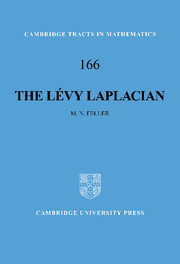Book contents
- Frontmatter
- Contents
- Introduction
- 1 The Lévy Laplacian
- 2 Lévy–Laplace operators
- 3 Symmetric Lévy–Laplace operator
- 4 Harmonic functions of infinitely many variables
- 5 Linear elliptic and parabolic equations with Lévy Laplacians
- 6 Quasilinear and nonlinear elliptic equations with Lévy Laplacians
- 7 Nonlinear parabolic equations with Lévy Laplacians
- Appendix Lévy–Dirichlet forms and associated Markov processes
- Bibliographic notes
- References
- Index
- Frontmatter
- Contents
- Introduction
- 1 The Lévy Laplacian
- 2 Lévy–Laplace operators
- 3 Symmetric Lévy–Laplace operator
- 4 Harmonic functions of infinitely many variables
- 5 Linear elliptic and parabolic equations with Lévy Laplacians
- 6 Quasilinear and nonlinear elliptic equations with Lévy Laplacians
- 7 Nonlinear parabolic equations with Lévy Laplacians
- Appendix Lévy–Dirichlet forms and associated Markov processes
- Bibliographic notes
- References
- Index
Summary
The Laplacian acting on functions of finitely many variables appeared in the works of Pierre Laplace (1749–1827) in 1782. After nearly a century and a half, the infinite-dimensional Laplacian was defined. In 1922 Paul Lévy (1886–1971) introduced the Laplacian for functions defined on infinite-dimensional spaces.
The infinite-dimensional analysis inspired by the book of Lévy Leçons d'analyse fonctionnelleattracted the attention of many mathematicians. This attention was stimulated by the very interesting properties of the Lévy Laplacian (which often do not have finite-dimensional analogues) and its various applications.
In a work (published posthumously in 1919) Gâteaux gave the definition of the mean value of the functional over a Hilbert sphere, obtained the formula for computation of the mean value for the integral functionals and formulated and solved (without explicit definition of the Laplacian) the Dirichlet problem for a sphere in a Hilbert space of functions. In this work he called harmonic those functionals which coincide with their mean values.
In a note written in 1919 , which complements the work of Gâteaux, Lévy gave the explicit definition of the Laplacian and described some of its characteristic properties for the functions defined on a Hilbert function space.
In 1922, in his bookand in another publicationLévy gave the definition of the Laplacian for functions defined on infinite-dimensional spaces and described its specific features.
Information
- Type
- Chapter
- Information
- The Lévy Laplacian , pp. 1 - 4Publisher: Cambridge University PressPrint publication year: 2005
Accessibility standard: Unknown
Why this information is here
This section outlines the accessibility features of this content - including support for screen readers, full keyboard navigation and high-contrast display options. This may not be relevant for you.Accessibility Information
- 1
- Cited by
